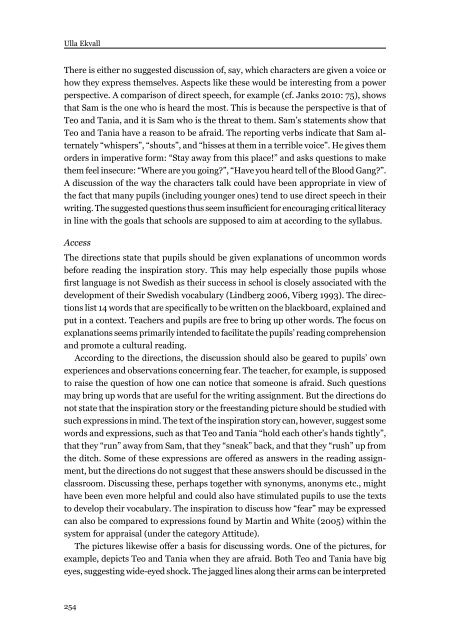Download issue - Umeå universitet
Download issue - Umeå universitet
Download issue - Umeå universitet
Create successful ePaper yourself
Turn your PDF publications into a flip-book with our unique Google optimized e-Paper software.
Ulla Ekvall<br />
There is either no suggested discussion of, say, which characters are given a voice or<br />
how they express themselves. Aspects like these would be interesting from a power<br />
perspective. A comparison of direct speech, for example (cf. Janks 2010: 75), shows<br />
that Sam is the one who is heard the most. This is because the perspective is that of<br />
Teo and Tania, and it is Sam who is the threat to them. Sam’s statements show that<br />
Teo and Tania have a reason to be afraid. The reporting verbs indicate that Sam alternately<br />
“whispers”, “shouts”, and “hisses at them in a terrible voice”. He gives them<br />
orders in imperative form: “Stay away from this place!” and asks questions to make<br />
them feel insecure: “Where are you going?”, “Have you heard tell of the Blood Gang?”.<br />
A discussion of the way the characters talk could have been appropriate in view of<br />
the fact that many pupils (including younger ones) tend to use direct speech in their<br />
writing. The suggested questions thus seem insufficient for encouraging critical literacy<br />
in line with the goals that schools are supposed to aim at according to the syllabus.<br />
Access<br />
The directions state that pupils should be given explanations of uncommon words<br />
before reading the inspiration story. This may help especially those pupils whose<br />
first language is not Swedish as their success in school is closely associated with the<br />
development of their Swedish vocabulary (Lindberg 2006, Viberg 1993). The directions<br />
list 14 words that are specifically to be written on the blackboard, explained and<br />
put in a context. Teachers and pupils are free to bring up other words. The focus on<br />
explanations seems primarily intended to facilitate the pupils’ reading comprehension<br />
and promote a cultural reading.<br />
According to the directions, the discussion should also be geared to pupils’ own<br />
experiences and observations concerning fear. The teacher, for example, is supposed<br />
to raise the question of how one can notice that someone is afraid. Such questions<br />
may bring up words that are useful for the writing assignment. But the directions do<br />
not state that the inspiration story or the freestanding picture should be studied with<br />
such expressions in mind. The text of the inspiration story can, however, suggest some<br />
words and expressions, such as that Teo and Tania “hold each other’s hands tightly”,<br />
that they “run” away from Sam, that they “sneak” back, and that they “rush” up from<br />
the ditch. Some of these expressions are offered as answers in the reading assignment,<br />
but the directions do not suggest that these answers should be discussed in the<br />
classroom. Discussing these, perhaps together with synonyms, anonyms etc., might<br />
have been even more helpful and could also have stimulated pupils to use the texts<br />
to develop their vocabulary. The inspiration to discuss how “fear” may be expressed<br />
can also be compared to expressions found by Martin and White (2005) within the<br />
system for appraisal (under the category Attitude).<br />
The pictures likewise offer a basis for discussing words. One of the pictures, for<br />
example, depicts Teo and Tania when they are afraid. Both Teo and Tania have big<br />
eyes, suggesting wide-eyed shock. The jagged lines along their arms can be interpreted<br />
254

















